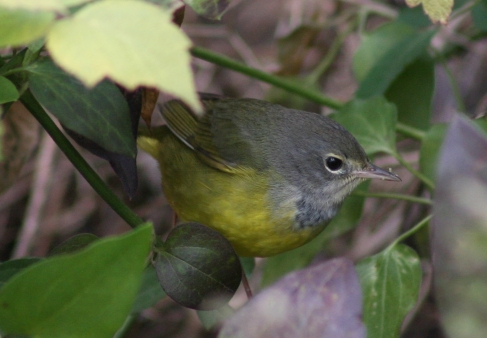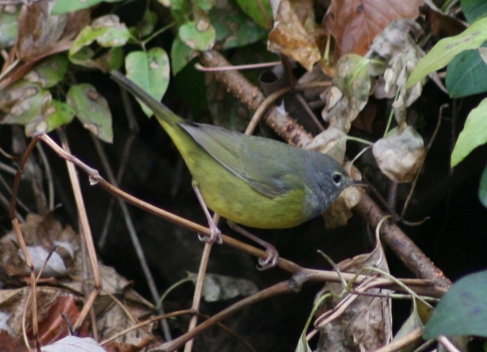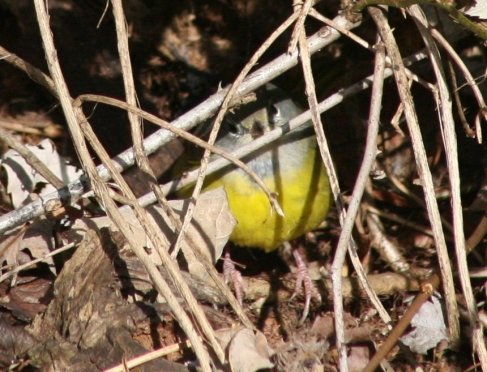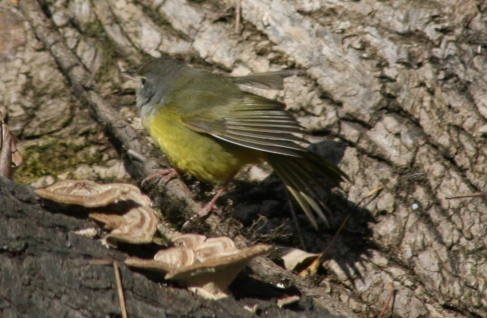“C’mon,” I coaxed. “Just budge over half an inch so I can get a picture of you.”
But the Golden-crowned Kinglet, intent on its pursuit of food, ignored my half-whispered plea as I crouched with my camera before my eye, finger poised lightly on the shutter button. Suddenly, a brilliant golden flash passed across the viewfinder’s field between me and my target. Warbler! flashed through my mind only half a nanosecond later. Could that have been a Common Yellowthroat? I asked myself, trying to think of other birds that might have such an intensely yellow underside. I looked away from the camera and into the brush just in time to see a yellow undertail disappear around a pile of logs several feet away and to my right. Definitely a warbler!
I was at the Borough of Highspire’s Reservoir Park on November 22, 2013, filling the wait for a prescription with what I had planned to be a half hour of watching ducks on the lake. But the Golden-crowned Kinglet had lured me onto the trail, and now, with my prescription and the Kinglet entirely forgotten, I strained to hear or see where the mystery warbler had gone. At that moment I sincerely wished I had brought along my Stokes Guide to Warblers, which includes undertail diagrams for every warbler, so I could check which warblers were yellow all the way to the back. But in lieu of that, I determined that I was NOT leaving the park without a usable photo for identification, or at least a careful visual study of field marks. Because, whatever it was, that glimpse of undertail told me that it most definitely did not belong in PA at the end of November!
Suddenly I heard a chip and spotted a flash of bright yellow half hidden behind tangled leaves and vines on a branch a few inches above the top of the log pile. I pulled the camera back up and checked the settings to be ready if it moved out into the open. But instead it darted across a few feet of open air and under more vegetation at the base of a nearby tree, so fast it was gone before I could twitch my finger on the shutter. But I could see its movement as it hopped along under a row of low brush, so I waited. Eventually it popped out into the open and paused, looking around. I squeezed off half a dozen shots with the camera then pulled up my binoculars to get a good look. It was not a Common Yellowthroat! But I was not sure what kind of warbler it was.
It was a tiny bird, with a blue-gray head and throat, olive-y brown back and wings, brilliant yellow breast and belly. It had white arcs above and below the eye, pink legs and a long tail. It continued foraging along the ground, constantly chipping as it hopped about; even after it ducked back under cover, I could hear its chip note as it moved farther from the trail. It was not a bird I had seen before, and didn’t quite match any of the warbler pictures in my Sibley field guide. But my experience has been that the birds I see do not always exactly match the field guide illustrations, and that fall warbler plumages offer even more variation than breeding plumages, so I tried to figure out which of the several similar possibilities was the closest and most likely. The blue-gray head and yellow underside quickly reduced the possibilities to a very few birds, and of the options available, I settled on “maybe a Nashville”.
When I posted a few shots to Facebook an hour later, it took less than a minute for someone to point out that it was NOT a Nashville, but it looked like a Mourning warbler. I remembered that Mourning was one of the options I had considered, and checked my pics against a few images that came up when I googled “Mourning Warbler”. Some of them looked pretty close, and although the Mourning Warbler did not have the eye arcs clearly seen on my pictures, the Nashville did not have a grayish throat. So I put a link to my photos along with a revised ID on the PABIRDS listserv and within a very few minutes received half a dozen responses, including Alex Lamoreaux’s suggestion that instead of a Mourning Warbler, it might be a MacGillivray’s Warbler, the Mourning Warbler’s Western counterpart. I had not even considered MacGillivray’s because it is a Western bird. Alex explained that because Mourning Warblers leave our area very early, migrating to their wintering grounds in late summer, it was actually more likely to be an extremely rare Western vagrant than a local bird getting a late start on migration. And a phenomenon began!
Shortly after Superstorm Sandy hit in 2012, I began to see an unfamiliar warbler around the Reservoir. Unfortunately, I was unable to get a usable photo, and it was mid-December before I even got good enough looks at it to come up with a tentative ID of Tennessee Warbler. And that ID was only because I could not find any distinguishing field marks that would clearly identify it as something else. I didn’t have enough confidence to share on the PABIRDS listserv, although I did mention in an eBird report that I had been seeing a warbler at the Reservoir that I could not identify. On January 1, nearly 2 months after my first sighting of it, my friend Renee Larry shot a photograph of a small yellowish bird perched atop some shrubbery while we were walking the trail together, even though she didn’t know what it was and I didn’t notice it at all. But when she posted it to Facebook, I immediately recognized it as my mystery bird. Finally there was a photographic record of the bird, so I sent a request for ID help to Andy McGann. It wasn’t until Andy replied that he and Tom Johnson believed it was a Tennessee Warbler that I posted the sighting on PABIRDS. And by then, it was too late. Even though several birders came to Highspire to try for it, the warbler was not seen again. As far as I know, Renee and I were the only two people who ever saw the (possible) Tennessee Warbler at Highspire. I didn’t want that to happen again. So I was very glad when Dick Williams posted an account of his sighting of the MacGillivray’s later in the afternoon of the 22nd.
November 23rd was a Saturday. When I arrived at the park around 8:45, I was amazed to see more than a dozen cars in the parking lot, and lots of people with cameras, binoculars and even spotting scopes. I was glad to see a few people I recognized – Annette Mathes, Ramsay Koury, Mike Epler, Dave McNaughton, and Ian Gardner – in the crowd at the first big bend in the trail. The bird had been seen and heard a little while earlier, but had been silent for some minutes when I arrived. It was close to half an hour before he appeared again, by which time the crowd had grown by half. It was very exciting to be part of what felt like a big event. Yesterday’s sighting had been a completely unexpected treat. Today there were serious expectations in the air. Everyone spoke in hushed voices, attempted to move along the gravel trail as soundlessly as possible, and all attention was focused on one thing: a tiny bird thousands of miles from where it belonged, unseen but a palpable presence, moving about in the brushy vegetation looking for bugs to eat.
Whenever the bird showed itself, however briefly, the clicking of camera shutters sounded all around me. Fortunately, it did not appear to disturb the bird, as it gave several opportunities for good long looks at it. When I got a chance to meet and speak with Alex, he told me that based on his observations he was convinced it was a MacGillivray’s. By this time, I had done a little more reading on the MacGillivray’s Warbler, and I could see for myself the distinctions he pointed out that argued for MacGillivray’s as the proper ID. He explained that there had already been a lot of discussion amongst numerous warbler experts and that with the wealth of observations, photographs and particularly with the video recordings that would hopefully have a clear audio record of its chip sounds, it would almost certainly be confirmed as a Mac. Within a few days, a consensus was reached that the bird was in fact an immature male MacGillivray’s Warbler, the 2nd ever in PA, and the first for Dauphin County
The MacGillivray’s Warbler (Geothlypis tolmiei) is a small bird, ranging from 3.9-5.9”, with a wingspan of about 7.5”; it weighs between 0.3-0.5 ounces¹. MacGillivray’s warblers breed throughout western North America from southern Alaska and much of western Canada, across the Pacific Northwest of the United States, east into Montana, south to southern California and central New Mexico and along much of the length of the Rocky Mountains. The fall migration route seems to be little understood, due to the bird’s secretive behavior, however, the primary fall migration route appears to run south between the West coast and the Rocky Mountains. In this range, MacGillivray’s Warblers are routinely observed on their southward migration all through the first half of November. They winter in Mexico, Central American and northern South America.
So, how did one end up in Highspire, PA? My theory is that the same massive storm system that spawned a devastating outbreak of tornadoes in Illinois on November 17 also delivered our vagrant warbler. That storm had its roots in a system that formed nearly a week earlier along the California coast, at a time when autumn’s northern migrants would be passing through the area, and proceeded from there southwestwards across the Rockies and toward the Gulf of Mexico, where it collided with another system before rampaging north and east until it finally petered out early on November 20, here in southcentral PA. This storm ultimately covered much of the US from the Great Plains eastwards across the Appalachians, and from the Gulf of Mexico to the Great Lakes². A migrant caught up in the storm could therefore have been carried east from the southern Rockies, then north up the Mississippi and Ohio River valleys to Pennsylvania, where it could have continued to ride the storm eastward until it was deposited in Highspire sometime between 11/19-20. Just speculation, of course; there’s no way to know for sure. All I do know is that around 11:30 on the morning of November 22, he flashed into my life and captured my attention for the duration of his stay.
Word of the visiting MacGillivray’s spread rapidly via birding listservs and Facebook pages. Over the seventeen days of sightings, visitors from all across Pennsylvania as well as New Jersey, Maryland, Virginia, Delaware and New York travelled to Highspire hoping to get a look. The majority of these guests were not disappointed. I was excited to meet many of them myself, and be able to see their excitement when they first spotted the Mac. After a few days it occurred to me to try to compile a list of Mac visitors. Between the people I met in person, email acknowledgments from many others, and people who posted their own photos/sighting accounts of the bird on Facebook, Flickr, Photobucket, etc., nearly 200 people that I know of came to Highspire and saw the Mac during his stay.
The Mac quickly established a pattern of behavior, foraging on either side of the nature trail from the northeastern corner of the old reservoir westward to a point midway along the third stretch of boardwalk on the trail. Maybe a quarter mile in walking terms, and somewhat less as the bird flies, he made his way from one end of “his” territory to the other several times a day. Abundant low-growing vines offered excellent cover and plenty of insect life for him to eat. He foraged right beside the trail or at a short distance, with little or no regard for the proximity of his audience. On one occasion he flew from a clump of tall grasses some 6 or 7 feet lower than the boardwalk to a hanging vine behind me, flying right by my face, less than 2 feet from me. Of all the exciting moments, that might have been the top for me! He was observed bathing in several places where water pools up or runs in to the reservoir. He was frequently seen in close proximity to other foraging birds. He generally ignored the Carolina and winter wrens, song sparrows, golden- and ruby-crowned kinglets but there were several yellow-rumped warblers that he would give chase to if they approached too close.
For seventeen days, he delighted visitors to the nature trail with his colorful presence and near-constant chipping commentary. Then he vanished as suddenly as he had appeared. I last saw him on December 7, and Dave McNaughton reported that he and several other birders enjoyed watching him on December 8. A winter storm the next day deposited 1-2 inches of snow on Highspire. Tom Johnson and a friend observed and photographed him in the snow on Dec. 9. After the snow it was a day or two before I could get over to the park, and when I did, I could not find any sign of him. He has not been seen since. I still listen and watch for him every time I walk the trail, although by this point I don’t expect to see him again.
Where he came from, how he got here, why he left, where he went – the questions will remain unanswered. That’s okay. I don’t need to know everything. What I do know is that one tiny wanderer brought color and excitement to a dreary end-of-autumn for me and much of the area’s birding community. For seventeen days.
¹ http://www.allaboutbirds.org/guide/MacGillivrays_Warbler/lifehistory
² http://www.crh.noaa.gov/ind/?n=nov172013outbreak









Leave a comment